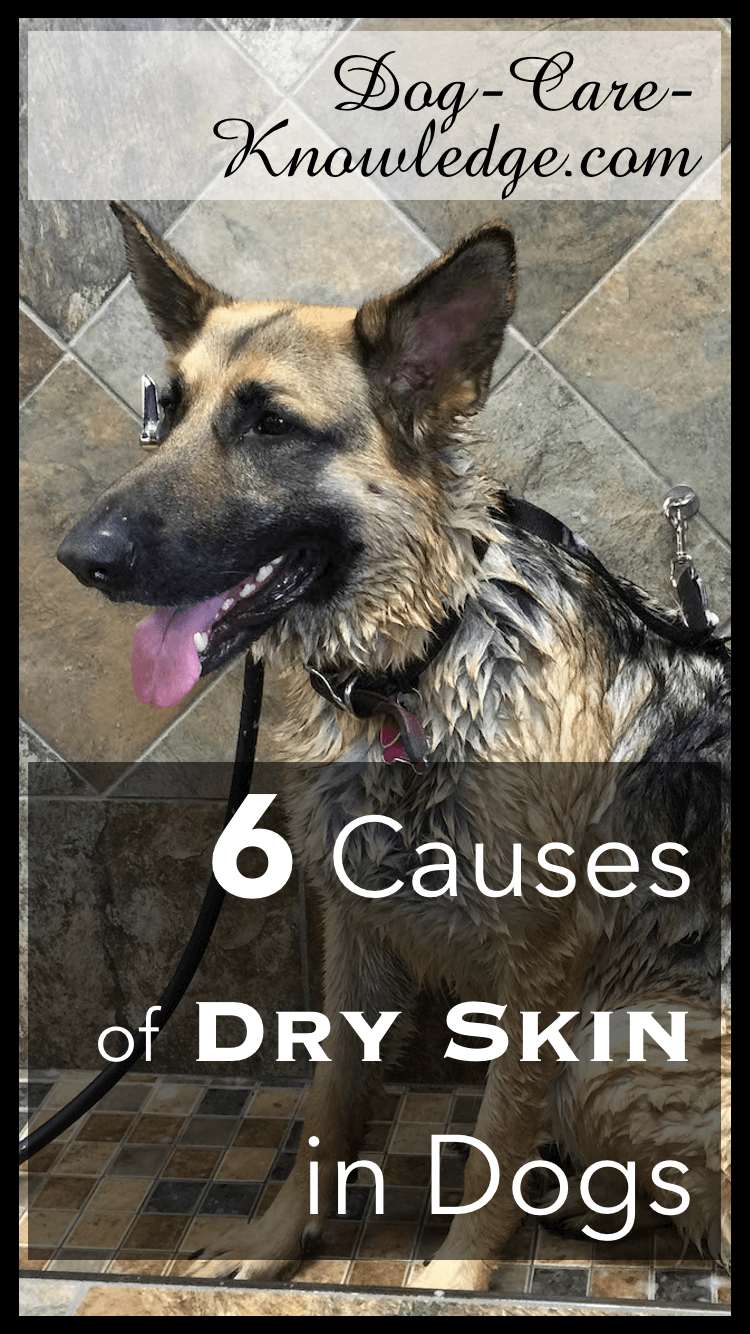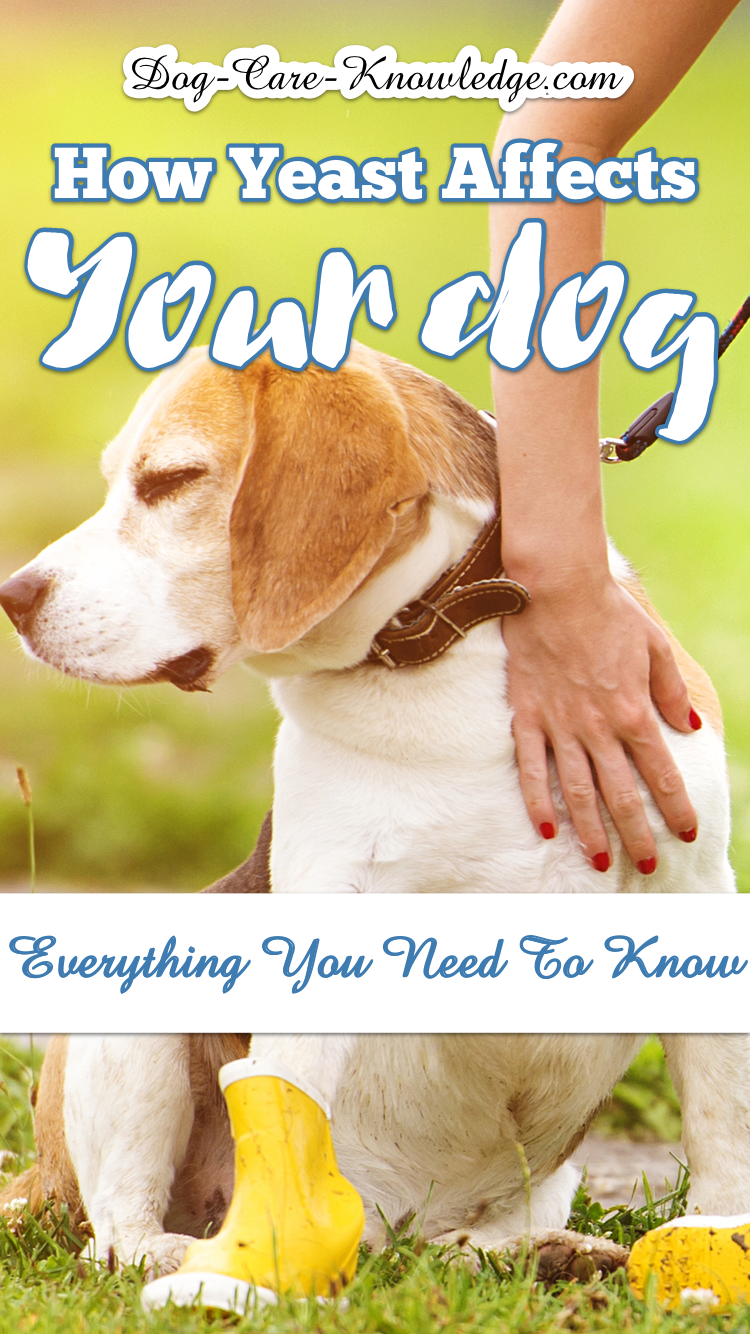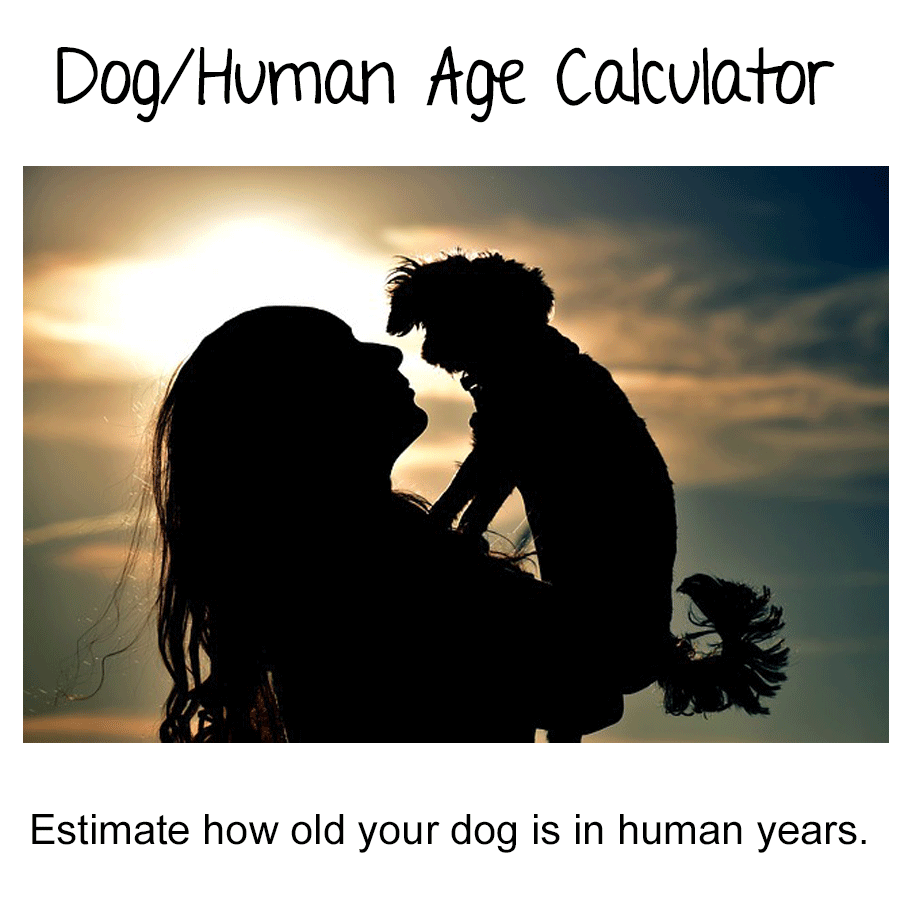- Home
- Skin Conditions
- Dry Skin on Dogs
- Home
- Itchy Dog?
- Dry Skin on Dogs
Understanding Dry Skin on Dogs:
An Overview
Dry skin on dogs is a common condition that many dog owners experience, including myself. It causes lots of itching, scratching, and is uncomfortable for our pets and frustrating for us when we’re unable to help.
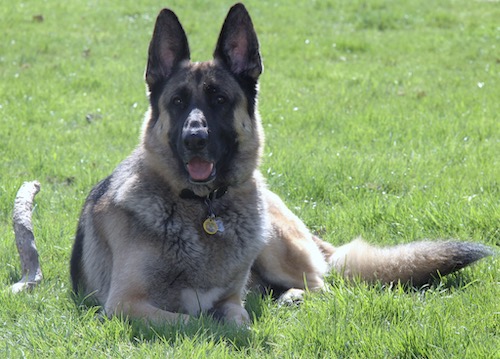
Meet my dog, Hudson. Like many dogs, he had persistent skin issues.
Dogs, like humans, can experience dry skin for different reasons. Some common causes include allergies, diet deficiencies, under or over-grooming, and even the weather or forced air heating, especially during colder months or in a dry climate.
For Hudson, it was always worse in the winter. This wasn't necessarily due to the cold weather but more to the heating being on high most of the day. It was also how I could differentiate between allergies and dry skin. Allergies are usually worse in the summer, and dry skin is worse in the winter. He also lacked essential oils in his diet, and I wasn't using the best shampoo. Again, more on this later.
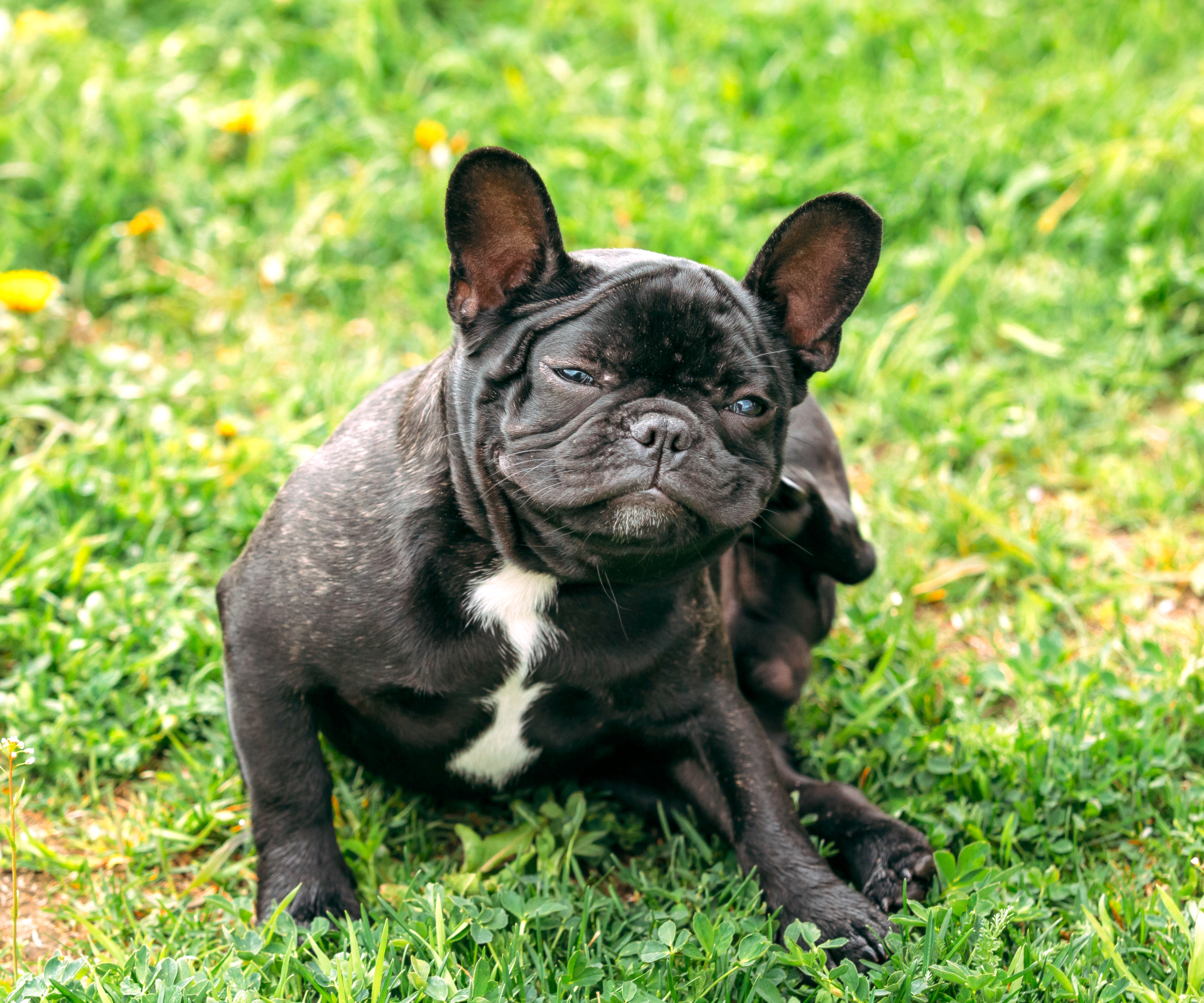
Symptoms of dry skin in dogs include:
- Constant itching or scratching
- Visible dandruff
- Hair loss
- Inflamed or red skin
- Cracked or rough skin patches
- Increased shedding
- Bumps, pimples, or blisters on the skin
- Signs of discomfort when skin is touched
- Unusual licking or chewing on certain areas
- Foul smell from the skin
- Changes in the skin color or texture
- Discharge or open sores on the skin
- Swelling or puffiness on the skin.
Not all dogs have all the symptoms, most of them have lots of scratching and itching, and a high percentage have visible dandruff, or dry white flakes. A significant first step in treating this condition involves identifying the root cause.
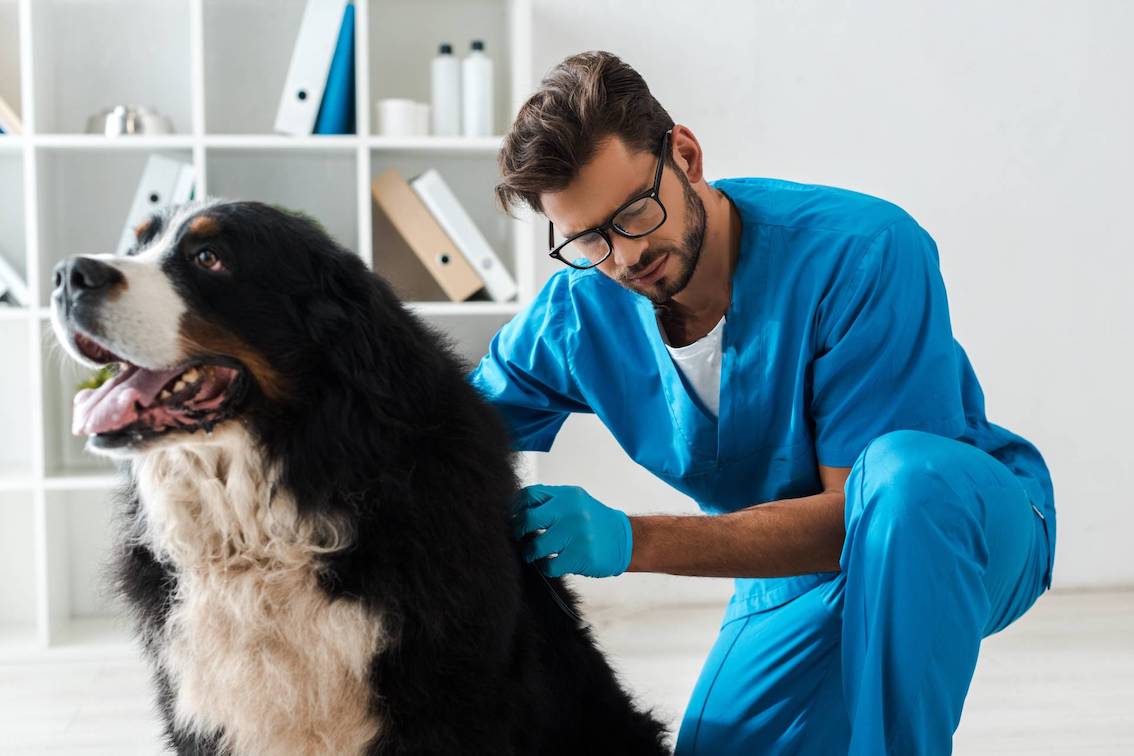
Top Six Causes of Dry Skin in Dogs
1) Nutrient Deficiency in Diet
Regarding diet, feeding your dog a balanced meal containing Omega-3 and Omega-6 fatty acids can promote hydrated, healthier skin. Foods rich in these nutrients include fish, flaxseeds, and walnuts. Sometimes, a simple change in the diet can bring a deep sense of relief as your dog's skin starts to return to its normal state.
A lack of omega-3 fatty acids is a prevalent cause of dry, flaky skin. Adding fish oil (fatty acids) to your dog's diet can help combat dry skin.
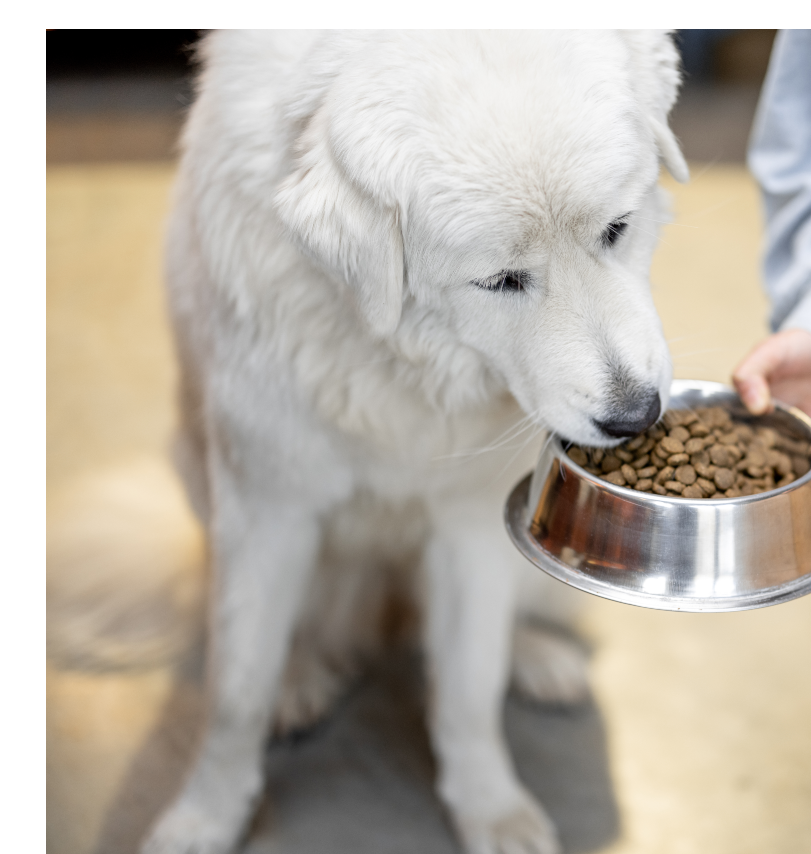
Unfortunately, many processed dog foods are heated to such high temperatures that even if they contain fatty acids, they are no longer active once they reach your dog's bowl.
The heating process virtually renders them useless, so supplementation of omega-3 is a good fix for dry skin. Salmon oil is an excellent source of omega-3 particularly, wild-caught Alaskan salmon, instead of farm-raised salmon.
2) Over or Under Bathing Your Dog
Ensuring your dog is groomed correctly will affect the condition of their skin. For this part, I asked the advice of a professional, Tarah Schwartz.
Tarah is a professional groomer, author, and has also worked as a veterinary technician and boarding kennel supervisor. Here's what she says about how grooming affects dry skin.
How Grooming Affects Dry Skin - A Groomer's Advice
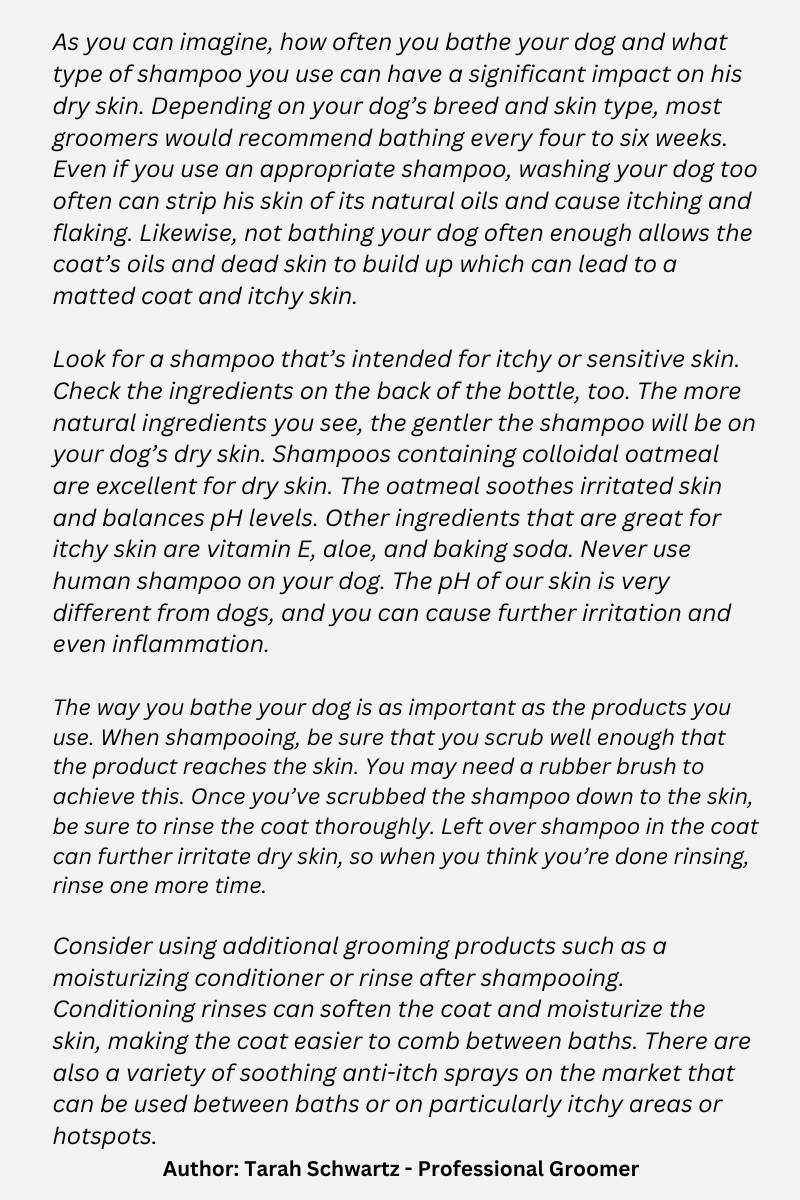
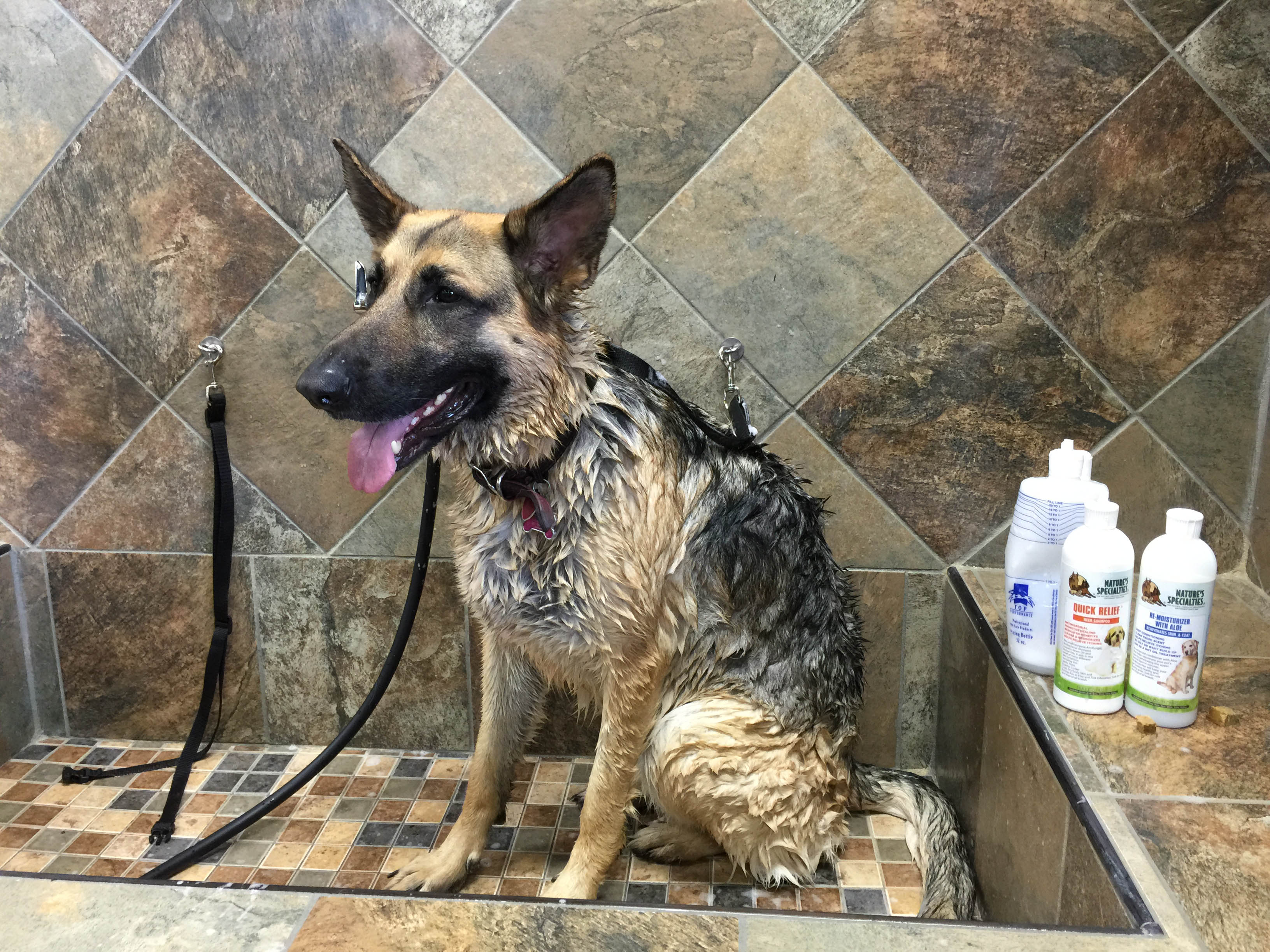
How Undergrooming Affects the Coat - A Groomer's Advicr
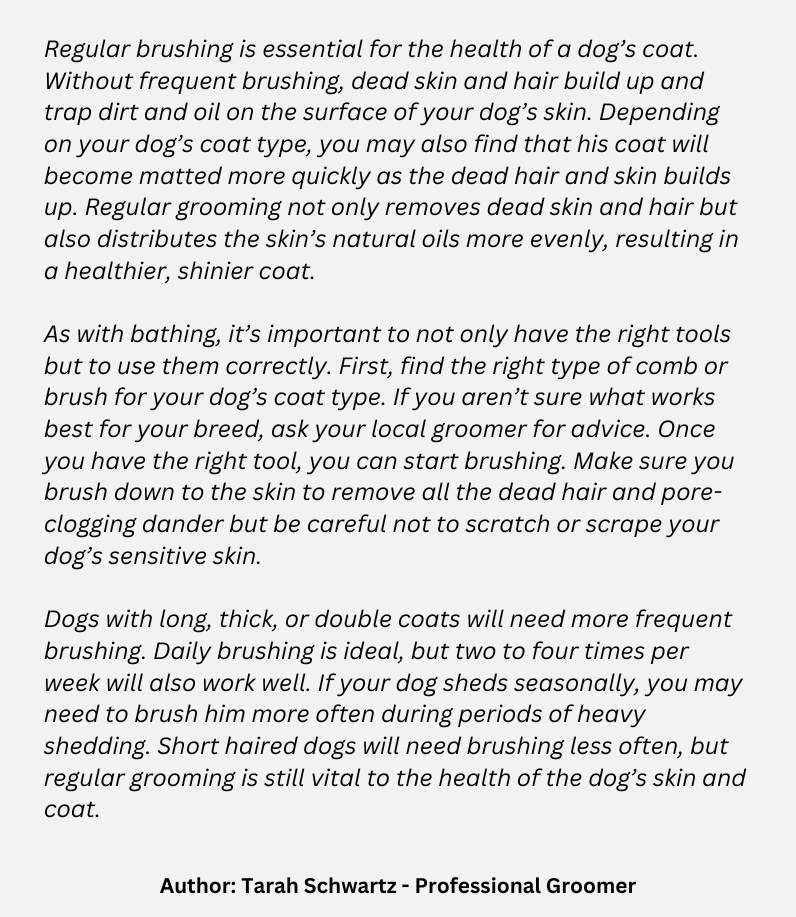
3) Dry Climate or Forced Air Heating
Basically, the drier the air, the more likely your dog will have dry skin. If you live in a dry climate, your dog is more likely to suffer from dry skin. The most common places for this type of weather are the southwest United States, northern Mexico, Argentina, North Africa, South Africa, and central parts of Australia. If you live in a dry climate, I'm sure you're already aware that it's dry, but here is a list of the driest cities in the United States.
Having said that, you don't have to live in a dry climate for your dog to suffer from dry skin. Many dogs outside these areas have dry skin, too, especially if they spend a lot of time indoors with dry air heating or meet all the other criteria above.
Forced dry air heating is another contributing factor that dries out a dog's skin. As the temperature outdoors drops, we typically crank up the heat indoors, which causes the skin to dry out, and there you have a perfect recipe for an itchy, scratchy dog.
If your best pal spends most of his time indoors (as mine do), a humidifier will help to stop his skin (and yours) from drying out.
Adding a humidifier to your home will mean the air will be more humid, making it feel warmer at cooler temperatures, so you'll be more comfortable with a lower thermostat setting. The humidity is also much better for skin (dogs and humans) and has the added benefit of reducing your overall heating costs.
You can get humidifiers that add moisture to a specific room, or if you want to increase the humidity in the entire house, you can opt for a unit that attaches directly to your existing furnace, which will pump additional moisture into all rooms
4) Neutering/Spaying
Neutered or spayed dogs have a much higher risk of suffering from skin and coat problems and unusually dry skin. Removing sex hormones can upset the natural balance of hormones that regulate oil production in the skin/coat.
I’m not saying you shouldn't neuter or spay your dogs; there are many good arguments for spaying and neutering. My dog, Hudson, was neutered at 18 months old.
Nevertheless, knowing that we need to be more aware of potential skin and coat problems, mainly dry skin, if our dogs are neutered/spayed is helpful.
5) The impact of Toxins on the Skin
Many skin conditions, including dry skin, result from a build-up of toxins in the body. If a dog's body or immune system cannot eliminate waste effectively, the body tries to push the problem outward toward the skin.
In this case, the skin becomes overburdened as the body attempts to steer the toxins away from the vital organs. Adding healing herbs that work to eliminate these toxins will help restore your dog's skin and coat.
Herbs that support the liver and blood work particularly well in this case.
6) Allergies
When a dog is allergic to a specific substance, be it food, environmental factors, or flea bites, their body's immune system responds to these 'allergens' by releasing histamines.
These histamines can cause inflammation, itching, and consequently, dry skin. The constant scratching due to the itch can lead to further skin irritation and even infections, exacerbating the dry skin condition.
It's essential that allergies are properly diagnosed and treated by a veterinarian to mitigate these skin issues.
How To Determine If Your Dog Has Dry Skin

First, ask yourself - How many of the above symptoms are you seeing? My dog had constant itching, visible dandruff, increased shedding (although, who can tell with a German Shepherd), and signs of discomfort when touching his skin.
I think my dog only experienced the early symptoms, but things could’ve progressed to the sores and puffiness on the skin, if his symptoms were not addressed.
Next, review the above common causes of dry skin in dogs and see if you identify with any. Again, Hudson's was caused by the cold weather, dry air, being neutered and lack of fatty acids in his diet.
Treatment For Dogs With Dry Skin
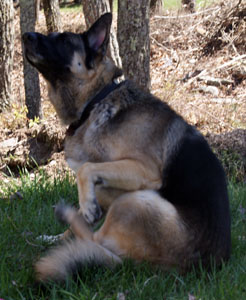
Hudson's Treatment Plan
After much trial and error, this is the treatment plan that I found works well for my dog's dry skin.
Every day I supplement Hudson's dinner with salmon oil. Even though he only really suffers from dry skin in the winter I still use salmon oil during the summer.
Reason being, supplements work best when they are given over more extended periods and can take a few months to get into their system to start working to support the skin.
I give him a good brush daily to stimulate his natural oils and to keep his skin in good condition.
What Shampoo to Use?
On a monthly basis I bathe Hudson with a good quality colloidal oatmeal shampoo and moisturizing rinse. You can use any brand of dog shampoo (not human), but check the ingredients to ensure it contains colloidal oatmeal AND that it doesn't contain a ton of synthetic ingredients.
If you see a whole list of long names that you have no idea what they are, then stay away from that product, it may do more harm than good. Even though it may still contain colloidal oatmeal, the other (synthetic ingredients) will probably outweigh the oatmeal proving it to be less effective in relieving your dog's dry skin.
The best products I found for dry skin is the Nature's Specialties range. They use the best natural ingredients which are nontoxic and biodegradable. I love this range and use it on my dogs all the time. I like colloidal oatmeal shampoo and moisturizing rinse that works well for dry skin in dogs.
Finish by washing the moisturizing rinse off leaving your dog's coat silky and soft and his skin re-moisturized.
The Power of Natural Ingredients in Treating Canine Dry Skin
An example of an excellent natural ingredient is colloidal oatmeal. Colloidal oatmeal, simply put, is oats ground into an extremely fine powder. This ingredient is known for its soothing properties, making it perfect for dry, inflamed skin, and thus a valuable component in managing dry skin in dogs.
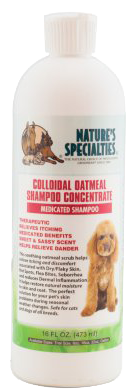
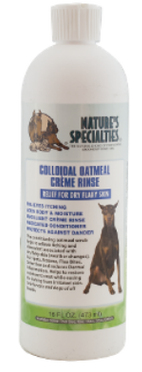
Another ingredient to consider in your dog's shampoo is aloe vera. It is renowned for its soothing and moisturizing properties and can help relieve your dog's dry skin symptoms. Alternatively, you can opt for shampoos containing jojoba oil, an excellent moisturizer that closely mimics their skin's natural oils.
Ingredients to Avoid in Dog Shampoo for Dry Skin
A common ingredient to avoid in your dog's shampoo is alcohol, which can cause dryness and irritation. Similarly, avoid products with artificial fragrances or colors, as they can further irritate your dog's skin.
Herbs That Treat Dry Skin
Burdock Root - is a valuable herb in many skin conditions unusually dry or scaly skin. Acting as a blood cleanser, it's particularly helpful in removing toxins from the liver and skin. Burdock is a powerful liver tonic that helps clean and build the blood.
Yellow Dock - is used extensively for all skin problems and also aids in eliminating toxins from the liver. Yellow Dock is a quick-cleansing herb that stimulates bile products and helps clean the blood. It's particularly useful for treating chronic skin conditions that may be attributed to toxic build-up
Red Clover - has been used in the treatment as a blood-purifying agent for hundreds of years, it also has anticancer properties. This herb is packed with nutrients that are effective against many skin disorders including dry skin.
Topical Solutions
Coconut oil - is a natural moisturizer that helps soothe and hydrate dry skin and is full of fatty acids and has antibacterial protection.
Aloe Vera - has anti-inflammatory properties proving it an excellent topical solution to reduce redness, irritation and itching.
Olive oil - is high in fats that can soothe and moisturize your dog's skin.
Coconut oil, olive oil, or aloe vera can be applied topically to help moisturize the affected area, this is beneficial especially if your dog’s scratching has caused irritation or redness. If you can manage to get past all that fur, topical solutions can help repair the affected area.
Below, is a simple home remedy using these herbs to treat dry skin as well as some guidance on how to apply the topical solutions.
Herbal Remedy for Dry Skin in Dogs
Ingredients:
- Burdock Root
Yellow Dock
Red Clover
Method:
- Combine equal parts of the above ingredients
- Grind ingredients well in a spice or coffee grinder
- Sprinkle on food daily per dog's weight (see chart below)
Dog's Weight
- 1- 10 lbs.
- 10 - 20 lbs
- 20 - 50 lbs.
- 50 - 100 lbs.
- Over 100 lbs.
Sprinkle on Dog's Food
(once per day)
- a small pinch
- a bigger pinch
- 2 pinches to 1 teaspoon
- 2 pinches to 2 teaspoons
- up to 1 tablespoon
Topical Home Remedies
When it comes to applying oils or lotions to your dog’s skin, it's a little bit more challenging getting past all the fur. Here’s what I found to be useful.
- Part the Hair - Start with a small section of fur. Part the hair down to the skin to expose it for treatment.
- Apply the Product - With the skin exposed, apply the oil or aloe vera lotion. If using coconut oil, ensure to warm it first. Massage it in gently, ensuring it thoroughly coats the skin but not so much it saturates the fur.
- Let It Soak In: Allow the product to soak into your dog's skin for a few minutes. This was always a challenge for me as my dog tried to lick it off or shimmy around in an attempt to rub the oil off - usually on the carpet. I found treats helped to keep his focus here.
- Towel Off: Wipe off any excess. Remember, the intention is to moisturize the skin, not to leave the fur oily.
- Move to The Next Patch: Move on to the next patch of skin by parting the hair and repeat the process.
- Monitor Your Dog: Be vigilant and watch for any signs of discomfort during the application.
You can also try olive oil. Like coconut oil, olive oil is high in fats that can soothe and moisturize your dog's skin. A little massage with olive oil can do wonders for dry skin.
Apple cider vinegar is another excellent home remedy due to its antiseptic properties, and it can help soothe itchy skin. However, never apply it on open wounds or extremely inflamed skin. Dilute the vinegar with water before applying.
Medication That Can Help
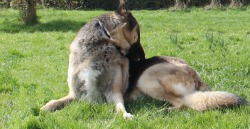
If your dog has severe itching, you can also include an antihistamine, but check with your vet. Start with the baths and moisturizing rinses before adding an antihistamine.
If you're using a different brand of shampoo, it may be worth swapping to Nature's Specialties range before adding an antihistamine.
An excellent antihistamine to try is Diphenhydramine (generic Benadryl). One brand many dog owners use is Banophen.
Dosage for Diphenhydramine (25mg)
1mg per pound of body weight 2/3 times per day
e.g. 75lb dog = 3 x 25mg tablets 3 times a day.
WARNING: Do not use any kind of antihistamine that contains decongestants or one that is used to treat multi-symptoms such as cold and flu medicines. These are toxic to dogs.
It should only contain Diphenhydramine as the active ingredient.
Diphenhydramine may causes drowsiness, see here for antihistamine alternatives.
Regular vet checks can help, too, as some underlying health issues may first present as skin dryness. Catching these early can make treatment more straightforward and less stressful for you and your furry friend.
Other Home Remedies
If you’re not keen on applying oils or lotions to your dog’s skin, another option is a homemade oatmeal bath. Mix colloidal oatmeal with lukewarm water and let your dog soak for about ten minutes. This remedy can provide temporary relief from itching and help moisturize their skin.
Apple cider vinegar has been touted as a home remedy for dry skin due to its antiseptic properties. However, I’m reluctant to recommend this as it shouldn’t be applied on open wounds or extremely inflamed skin. I don’t think we ever really know how “inflamed” or sensitive our dog’s skin is.
I once tried this on my other dog’s paws and it was a disaster. She was hopping around like her feet were on fire. I had to dunk her feet in cool water immediately, luckily we were outside close to her paddling pool so she happily jumped in there. Since then, I’ve never used any apple cider vinegar remedies on my dogs. If you do want to give it a try ensure you dilute the vinegar with water before applying. And, speaking from bitter experience, it’s also a good idea to have cool water close by in case you need to get it off quickly.
When to Seek Veterinary Help for Your Dog's Dry Skin
While home remedies and over-the-counter products can be effective for mild cases of dry skin, not every case can be resolved at home. If you notice that your dog's dry skin does not improve after a few weeks of home treatment, it might be time to see your veterinarian. It's important to note that persistent dry skin issues can indicate more significant health concerns like endocrine disorders or metabolic issues. These conditions need a veterinarian's diagnosis and treatment regimen
Your vet will take a comprehensive approach to diagnose the condition. This may involve a thorough examination, skin scraping tests, blood tests, or even a biopsy in severe cases
Treatment provided by the vet may involve medicated creams or lotions, special shampoos, or even corticosteroids in some cases. In cases of nutritional deficiencies causing dry skin, your vet could recommend dietary supplements or a change in diet
Medication That Can Help
If your dog has severe itching, you can also include an antihistamine, but check with your vet first.
If an antihistamine sounds like something you’d like to try, the active ingredient to look for is Diphenhydramine also known as Benadryl. But be careful that Diphenhydramine is the ONLY ingredient. Many antihistamines also contain some form of decongestants that help with cold and flu systems but decongestants are toxic to dogs.
There’s also a prescription chewable version for pets called Vetadryl. This is available in smaller doses (10mg) as well as the regular dose (25mg). Vetadryl might be easier If you find working out the dosage difficult or confusing, as your vet will give you exact dosages. The 10mg tables are also easier to give to those little guys out there that require smaller doses.
- Dosage for Diphenhydramine (25mg)
- 1mg per pound of body weight 2/3 times per day
- e.g. 75lb dog = 3 x 25mg tablets 3 times a day.
I found using a good shampoo and moisturizer was enough for Hudson so haven't tried an antihistamine.
Dry skin is a common ailment, especially in the winter. My hope is that my experience and this information provides you with the right knowledge to effectively tackle this issue.
